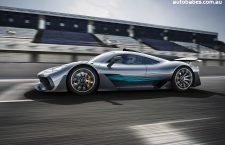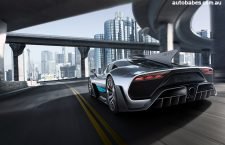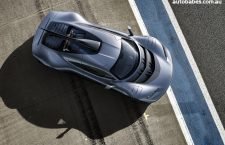
The Mercedes-AMG Project ONE will celebrate its world première at the International Motor Show (IAA) in Frankfurt/Main: for the first time, the two-seater supersports show car brings the very latest and efficient, fully-fledged Formula 1 hybrid technology from the race track to the road almost par for par to represent the highlight of AMG’s 50th anniversary. This high-performance hybrid is said to produce over 1.000 hp and reach top speeds beyond 350 km/h. The show car combines outstanding race track performance and day-to-day suitable Formula 1 hybrid technology with exemplary efficiency. This is a world first. The overall responsibility for the realisation of Project ONE lies with Mercedes-AMG. The complex development work was carried out in close cooperation with the Formula 1 experts at Mercedes-AMG High Performance Powertrains in Brixworth and with the Mercedes-AMG Petronas Motorsport team in Brackley. Together with the four-door AMG GT Concept, the Mercedes-AMG Project ONE provides another insight into the future performance-hybrid drive strategy of the sports car brand within Mercedes-Benz.
Ever since the early days of motorsport, engineers have dreamed of bringing motor racing technology to the road. Mercedes-AMG is now making this dream a reality at the very highest level.
“Motorsport is not an end in itself for us. Faced with intense competition, we develop technologies from which our production vehicles also subsequently benefit. We are drawing on our experiences and successes from three constructors’ and drivers’ world championships to bring Formula 1 technology to the road for the first time: in Mercedes-AMG Project ONE”, says Dr Dieter Zetsche, Chairman of the Board of Management of Daimler AG and Head of Mercedes-Benz Cars.
“The Mercedes-AMG Project ONE is the first Formula 1 car with MOT approval. Our highly efficient hybrid assembly stems from motor racing and the electrically powered front axle generates a fascinating mixture of performance and efficiency. With a system output of over 1,000 hp and a top speed beyond 350 km/h this hypercar handles exactly as it looks: it takes your breath away”, Ola Källenius says, Member of the Daimler AG Board of Management responsible for Group Research and Mercedes-Benz Cars Development.
The concept car gives specific indications of what to expect from the upcoming production model.
“The hypercar is the most ambitious project we have every undertaken. It marks yet another pinnacle of the successful, strategic development of Mercedes-AMG towards a performance and sports car brand. Project ONE raises the bar in terms of what is currently technologically feasible and thanks to its combination of efficiency and performance it represents an absolute benchmark. At the same time, Project ONE provides an outlook on how AMG will define driving performance in the future”, Tobias Moers explains as the Head of Management at Mercedes-AMG GmbH.
The high-performance plug-in hybrid drive system of the Mercedes-AMG Project ONE comes directly from Formula 1, and was realised in close cooperation with the motorsport experts of Mercedes-AMG High Performance Powertrains in Brixworth. It consists of a highly integrated and intelligently networked unit comprising one hybrid, turbocharged combustion engine with a total of four electric motors. One has been integrated into the turbocharger, another has been installed directly on the combustion engine with a link to the crankcase and the two remaining motors drive the front wheels.
The 1.6-litre V6 hybrid petrol engine with direct injection and electrically assisted single turbocharging comes directly from the Mercedes-AMG Petronas Formula 1 racing car. The four overhead camshafts are driven by spur gears. To achieve high engine speeds, the mechanical valve springs have been replaced by pneumatic valve springs. The vehicle is mid-engined (ahead of the rear axle) and it can easily reach speeds of 11,000 rpm, which is currently unique for a roadgoing vehicle. However, for higher longevity and the use of commercially available Super Plus petrol instead of racing fuel, it remains significantly below the F1 engine speed limit.
The electric motors on the front axle are also true rev wonders, with rotor revolutions up to 50,000 rpm – current state of the art is a speed of 20,000 rpm.
The very high-revving engine is additionally boosted by a high-tech turbocharger. The exhaust gas and compressor turbines are separated from one another and located at an optimum position to the exhaust side and to the intake side of the V6 engine, and connected to one another by a shaft. This shaft features an electric motor with approximately 90 kW which, depending on the operating status, electrically drives the compressor turbine with up to 100,000 rpm – for instance when moving off or following load changes. The Formula 1 designation for this unit is MGU-H (Motor Generator Unit Heat).
The major advantage: the dreaded turbo lag – the delayed response to accelerator pedal commands owing to the inertia of the large charger – is completely eliminated. The response time is greatly reduced, and is even shorter than that of a naturally aspirated V8 engine. The electric turbocharger brings about another advantage: it uses parts of the surplus energy from the exhaust system to generate electricity, and either stores it in the high-voltage lithium-ion battery as part of recuperation or provides additional drive power by feeding it to an additional electric motor. This motor produces 120 kW, has been installed directly on the engine and features a link to the crankshaft via a spur gear (MGU-K = Motor Generator Unit Kinetic) – another technology that ensures maximum efficiency and performance in Formula 1.
There will also be two further 120 kW electric motors at the front axle. Each is connected to a front wheel via a reduction gear. The fully electrically driven front axle allows individual acceleration and braking of each front wheel, and therefore selective torque distribution (torque vectoring) for particularly high levels of vehicle dynamics. With the axle motors, we estimate that up to 80 percent of the braking energy can also be optimally used for recuperation under everyday driving conditions. This energy is stored in the battery and is available for a longer electric range. Each electric motor is controlled by its own power electronics located in close proximity to the electric motors in the floor assembly.
The thermal efficiency of the combustion engine with electric turbocharger (MGU-H) in conjunction with the electric motor on the crankshaft (MGU-K) will be over 40 percent. This is a previously unattained peak value for series production vehicles, and confirms the dominant position of the drive system where efficiency is concerned. This means that the show car obtains significantly more drive energy from one litre of fuel than other cars. It is therefore both economical and powerful. By way of comparison, the thermodynamic efficiency of conventional series production engines is around 33 to 38 percent.
The battery cells, their arrangement and the cell cooling system are the same as used in the Mercedes-AMG Petronas Formula 1 racing car. However, the quantity of battery cells in the AMG Project ONE will make it significantly more practical for everyday use. The lithium-ion, high-voltage battery and the DC/DC converter supporting and charging the 12 V onboard electrical system are space-savingly accommodated in the vehicle floor behind the front axle.
As a further innovation, the high-voltage EQ Power+ drive system operates with 800 volts instead of the usual 400 volts. Thanks to the higher voltage levels it is possible to influence elements, such as significantly reducing the cable diameters and accordingly saving design space and weight.
Overall the high-performance EQ Power+ plug-in hybrid drive system offers numerous intelligent operating strategies which are optimally tuned to different application scenarios. The driving modes range from purely electric operation through to a highly dynamic mode which corresponds to a setting used in Formula 1 qualifying for optimum lap times. Despite the high system complexity, and depending on the current requirement, the driver will always receive the optimum combination of performance and efficiency. In this process, Mercedes-AMG engineers make use of the many years of experience and know-how from Formula 1, the SLS AMG Electric Drive and Daimler AG’s research and development.
For instance, the driver can move off purely electrically, initially with just the electric motors on the front axle driving the hypercar and the electric motor on the crankshaft supporting short-term acceleration wishes. If the driver presses the accelerator more firmly and demands more output, the V6 engine also switches on. The drive system unfolds its full power as the engine speed increases. Impressive acceleration figures are possible with the Race Start function: acceleration from zero to 200 km/h takes under six seconds.
If the driver’s foot leaves the accelerator again to let the car coast, the system switches to electric drive at the front axle – whilst braking under normal driving conditions recuperates up to 80 percent of the energy, which is fed into the battery.
Power is transferred to the rear wheels by an 8-speed manual transmission that has been entirely developed from scratch for the Mercedes-AMG Project ONE. It is activated hydraulically and can be operated in automated mode or manually using the shift paddles.
The basis for the outstanding driving characteristics of the Mercedes-AMG Project ONE is provided by the lightweight, high-strength carbon-fibre monocoque body, the technology of which likewise comes from Formula 1. The same applies to integration of the engine and transmission: both have load-bearing functions and completely support the rear suspension.
The suspension developers also gave their utmost. Multi-link designs are used at the front and rear. The adjustable coil-over suspension has several special features: Both push-rod spring struts have been installed across the direction of travel. The innovative arrangement of the spring/damper unit replaces the function and application of conventional tubular cross members. This solution reliably prevents rolling movements even during very rapid directional changes, without being uncomfortable.
The overall setup of the springs and dampers is configured for perfectly balanced, easily controlled and above all sporty handling characteristics. These are also assisted by all-wheel drive and torque vectoring. ABS is standard equipment, with ESP® adjustable in three stages as is usual for AMG. ESP® ON stands for a high level of safety, ESP® SPORT HANDLING MODE allows greater yaw angles before system intervention for a sporty driving style, and ESP® OFF switches the system off for sporty driving on enclosed racetracks.
Another completely new development is the 10-spoke forged aluminium wheel with centre lock, which is exclusively reserved for the Mercedes-AMG Project ONE. This has a radial carbon-fibre semi-cover with an aerodynamically sophisticated shape: this improves the car’s aerodynamics and Cd figure by optimising the airflow around the wheels.
At the same time, three flat ventilation slots per spoke section ensure optimum heat dissipation from the brakes. This is another example of how the AMG development team pays the utmost attention to even the smallest aspects, so as to improve the efficiency of the hypercar.
At the front the Mercedes-AMG Project ONE runs on 10.0 J x 19 dimension wheels and 285/35 ZR 19 Michelin Pilot Sport Cup 2 tyres which were exclusively developed for the hypercar and at the rear the vehicle features 12.0 J x 20 wheels running on Michelin Pilot Sport Cup 2 335/30 ZR 20 tyres.
The car is equipped with an advanced, weight-optimised ceramic high-performance compound braking system. Its low weight reduces the unsprung masses, thus improving driving dynamics and agility. Furthermore, the ceramic brakes are distinguished by a longer service life, higher corrosion resistance and higher thermal stability. The “AMG Carbon Ceramic” lettering and the specially painted brake callipers visually distinguish this unique braking system.
The design of the show car is very obviously inspired by the premium class in motorsport. But above all, it embodies the Mercedes-AMG principle that fascination is always linked with function. Every part has a specific purpose. The result is a mid-engine concept, extremely muscular proportions with the cockpit well forward, large wheel arches, a wasp waist and an extended rear end.
“The Mercedes-AMG Project ONE is the hottest and coolest car we have ever designed. It combines our design philosophy of Sensual Purity with the performance of our Formula 1 racing cars and is the perfect embodiment of Performance Luxury,” says Gorden Wagener, Chief Design Officer Daimler AG. “This hypercar’s extreme design marks a milestone in design ‑ there are no lines, and the interior is stripped down to the essentials.”
The front view is characterised by the large front apron, the various air inlets of which extend across the entire vehicle width. The trapezoidal centre section bears a large, white AMG logo. Above it, on the vehicle body, is the Mercedes star. The hallmark AMG A-wing below the centre section creates a silver-coloured highlight, and seamlessly transitions into the front wings.
On the left and right are large, prominent air inlets which are framed by U-shaped flaps and each subdivided by two black horizontal fins. Flat LED headlamps blend seamlessly into the body contours.
The black air outlets in the bonnet guide the hot airflow around the sides of the driver compartment. This allows the flow of fresh air to pass unhindered across the driver compartment and into the intake tract on the roof. The downforce at the front axle is positively influenced by the automatically extending front splitter and the active ventilation louvres in the front wheel arches, contributing to the perfect aerobalance of the car.
The low, dynamic greenhouse has an unmistakable, spherical architecture with a distinctive window pattern. The large, dark area stands for important technical functions. These technical components form a visual contrast to the clean overall lines of the vehicle.
The roof line is dominated by an air intake derived from Formula 1, via which the engine takes in large volumes of air. The black intake transitions elegantly into the black, vertical shark fin, which improves lateral stability when cornering at high speed. The rear window placed well to the rear is an integral part of the intake/roof-fin unit. It allows a view of the power unit. Two large NACA air inlets ensure optimum guidance of the airflows for the engine and transmission oil coolers located at the rear end.
The side view also shows a sensuous, clean surface design combined with functional features. The vehicle flanks are tautly recessed, with black carbon-fibre surfaces redirecting the airflow around the vehicle body as in motorsport.
The Petronas green paintbrush design on the flanks is the work of the artist who designed the paintwork for the Formula 1 racing car. All four wheels are spanned by tight-fitting, muscular wings that appear ready to leap into action.
As in motor racing, the doors open both forwards and upwards. The fuel filler flap is at the rear right, the charge socket for the plug-in hybrid battery at the rear left.
The sharp, vertical spoiler lip and the large, two-section diffuser, which is interrupted by the central exhaust tailpipe, as well as the two-stage extendible rear aerofoil, contribute to aerodynamic efficiency and performance at high speeds. The design of the exhaust tailpipe with its large, round outlet and two further small, round apertures was adopted directly from the Formula 1 cars.
The muscular appearance is further enhanced by the rear apron with its large, black mesh and carbon-fibre components. The rear lights each feature three rhomboid lighting elements to echo the graphic design of the AMG brand logo, and therefore also the design of the headlamps.
The interior design concept of this ultimate driving machine follows function on the racetrack, and this is expressed in the radical design idiom. Formula 1 technology is made authentically tangible on both the race track and the road. Here too every detail has a function, with nothing included merely for visual reasons. In the monocoque interior, the reduced components are emphasised in minimalist style both in design and functional terms.
The ergonomically contoured interior has room for two occupants. The bucket seats with adjustable backrests are integrated into the monocoque. The pedals and steering wheel are adjustable, allowing the driver to adopt the ideal driving position. The centre tunnel visually separates the driver and passenger areas from each other. It blends fully into the seat sculpture and follows the principle of minimalism with its gently rising contour.
The lightweight construction is also obvious from the slim, wing-like profile of the dashboard. It appears to be light and free-floating. As a functional, structural component it also rigidifies the monocoque of the Mercedes-AMG Project ONE. The two high-resolution, free-standing 10-inch displays (one slightly raised in front of the driver, the other on the right of the centre console angled towards the driver) are adapted with high-quality and weight-optimised solid metal components.
The double-nozzle ventilation unit is suspended under the centre screen like a gondola. The screen and nozzles form a single unit, emphasising the lightweight design principle of the whole. The displays’ rectangular basic form is echoed by the ventilation nozzles, and by the centre console in which the start/stop button is located.
Also seamlessly integrated as a unit are a high-quality stowage compartment, a reduced switch array and the engine start button. The stowage compartment is fitted with a transparent lid.
The steering wheel with flattened upper and lower sections and an integrated airbag offers motorsport functionality, as do the two integrated controllers which can be used to set adjustment functions, such as the driving modes and suspension setup, or the LED shift display in the upper steering wheel area.
The door panels are in functional, high-grade carbon-fibre, and integrate smoothly into the sporty interior. As if to mirror the aero winglets of the exterior, the door panelling is visually interrupted to create space for technical implements and a generously concave door centre panel. An aluminium cassette combines the air vents and power window switches, which are integrated as deeply recessed rectangles.
Stowage compartments behind the seats, screen replaces interior mirror.
Neither have the Mercedes-AMG developers forgotten suitability for everyday use and operating convenience: small items can be stowed in two compartments on the left and right behind the seats. An air conditioning system and power windows are standard equipment, while the COMAND infotainment system ensures optimum connectivity.
The user interface is integrated as an autonomous concept. The most important information is displayed on the road in the line of vision above the steering wheel, so that the driver is not distracted. To ensure optimum visibility to the rear, the rear-view mirror is replaced by a screen showing real-time images of the rear from a mirror cam. The aluminium screen housing is fully integrated into the roof, and also holds other controls.
The choice of colours and materials takes its inspiration from the Mercedes-AMG Petronas Formula 1 racing car. The sculptured racing seats are in slip-resistant black microfibre, creating an unmistakable association with motor racing. The seat surfaces are interspersed with nappa leather in magma grey and inlays in a sporty textile mesh which optimally assists the air circulation of the seats. There is also yellow contrasting topstitching.
Conclusion: The Mercedes-AMG Project ONE will not only be an ultimate driving machine that directly brings current Formula 1 hybrid technology onto the road and combines top-class race track performance with full day-to-day suitability. Its purpose is also to obtain extensive findings about performance-oriented plug-in hybrid drive technology, further developments of suspension layouts and extended onboard electronics that will later benefit series production AMG cars. The Project ONE team is working hard on successfully bringing this vision onto the road.
|
||||||||||||||||||||||||||||||||||||||||||||||||||||||||

















Be the first to comment